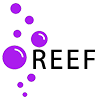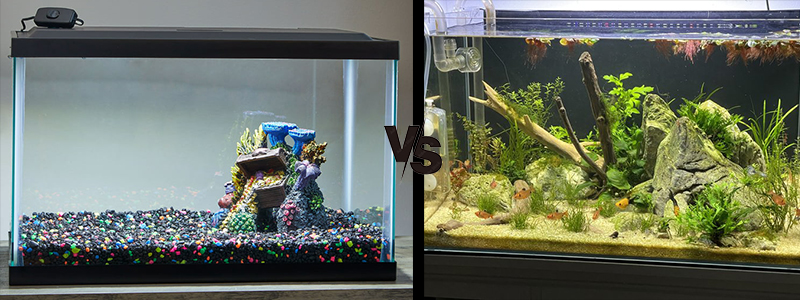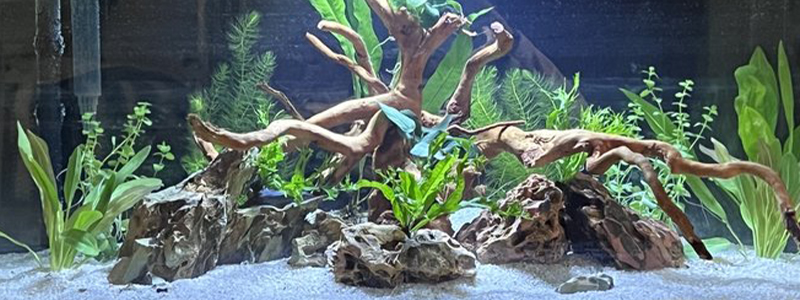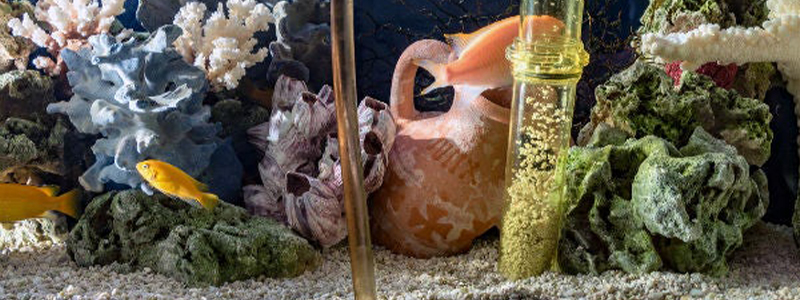Pico tanks… nano tanks… 50 gallon tanks… 250 gallon tanks… framed tanks… rimless tanks… aquariums made of acrylic… aquariums made of glass — trying to decide what kind of aquarium to choose can seem a little overwhelming. Fortunately, answering five simple questions can help make the choice much easier.
1) What is your budget?
This one may seem obvious, but it can still catch people by surprise. The reason: the long list of supporting equipment. Good, new, reliable mid-grade equipment can cost 3 or 4 times as much as the tank itself.
That shiny, new 120 gallon reef-ready tank may seem affordable at $800. However, once you add in the cost of a decent stand and mid-grade lights, power heads, a sump, protein skimmer, reverse osmosis / deionization system, live rock, live sand and all the other supporting equipment, you could easily be looking at over $3,000. If you go with top-of-line equipment, you could be looking as much as $6,000 or more.
Disclosure: This article contains affiliate links. When you follow a link to purchase the products, I sometime earn a commission, at no additional cost to you. Read my full disclosure here.
Here are a few potential ways you can approach it…
You can ‘divide by five’ to put together your own new, custom aquarium set-up: If you want both a new aquarium tank and the freedom to select your own pieces of equipment to pair up with it you can narrow down your search by dividing your budget by 5 — then use that as your budget for the aquarium tank itself. For example, let’s say you have $3,000 total to spend on a complete set-up: $3,000/5=$600. So you would focus your selection on tank sizes and types that are $600 or less. That would leave you $2,400 to spend on everything else, which, if you resist the urge to buy the fanciest, cutting-edge pieces of equipment, should provide you with a pretty nice set-up without breaking your budget.
The benefits of this approach:
- You can tailor the equipment to whatever level of quality and features you desire (keep an eye on that budget though!)
- It gives you the flexibility to expand or upgrade your system in the future without having to replace a lot of equipment to do so.
The drawback:
- It’s the most expensive approach to putting together a saltwater aquarium.
You can go with a new All-In-One (AIO) or ‘mostly-in-one’ set-up: Many companies such as Elos, Innovative Marine, Red Sea, and Coralife (just to name a few) provide aquarium set-ups that already have all, or most of the supporting equipment included.
The benefits:
- You can often get more tank (e.g. bigger) for less money
- You don’t have to bother with shopping for the supporting equipment.
The drawbacks are that:
- You have little say in the type or bands of supporting equipment included
- The equipment included may not be sufficient for some of your long term goals. For example, the light included with it may be more than enough for fish and soft corals, but too weak for popular SPS (small polyp stony) corals
- Less flexibility for upgrading in the future — there may not be sufficient room for adding or upgrading equipment as your size, type, and number of your coral and other inhabitants grow
You can shop used:
Whether it’s people upgrading their systems, or people leaving the hobby, you can ALWAYS find tons of used aquarium tanks… equipment… even complete, flourishing reef tanks — coral, fish, and all — up for sale at VERY affordable prices in a variety of places. Three of the best to look to at — in order of reliability — are local reef club websites (check out aquaworldaquarium.com for clubs near you), online aquarist forums (such as reefcentral.com and nano-reefs.com), and craigslist.org.
The benefits are:
- lower prices because you’re buying used
- the potential to make new friendships and connections with other aquarists
The drawbacks are:
- The possibility the equipment may hidden problems, been abused, or is nearing the end of its lifespan. Even if you buy from a very honest and dependable seller, there is no guarantee that ordinary use or circumstances may have taken their toll on the equipment
- Little or no chance of recourse if you do get a lemon (e.g. no manufacturer’s warranty)
- Cross-contamination. CLEAN used equipment well. While the odds it happening are somewhat low, if the previous owner had an algae or other ‘hitchhiker’ problem, remnants on the equipment could make there way into your tank too…
Once you have your budget and shopping market (e.g. new separates, new all-in-one, or used) nailed down, it’s time to take a closer look at…
2) How much space do you have for the tank… and the rest of the equipment?
Be sure to take into account not only the footprint of the aquarium itself but also equipment storage space and work space.
Two things to keep in mind…
- Most aquarium stands will be occupied by a sump, automatic-top-off container, and other gadgets and primary pieces of equipment. This means other secondary equipment such as salt, test kits, spare heaters or powerheads, quarantine equipment and whatnot may need to be stored — and take up space — somewhere else
- An RODI (reverse osmosis/deionization system — which plays a key role pure, clean water for your aquarium) and accompanying water storage containers will take up a pretty fair amount of their own space in another part of your home
- There should be enough room around the tank for tank cleaning, water changes, and tank maintenance. And other work space elsewhere in your home for water preparation and storage will come in handy as well.
That said, if you have space for a nice 48″ x 24″ x 20″ 1oo gallon reef-ready aquarium but don’t have spare storage space, stepping down to a 50 gallon tank (smaller sized equipment) or even a 50 gallon All-In-One (with equipment in a back chamber) may free up storage space in the tank stand, give you a more comfortable amount of space to work in, and be a much more enjoyable fit.
Likewise, if you have ample space for a 100 gallon tank, you may find that bumping up to a 120 gallon won’t take up much more room than the 100g while still giving you a fair bit more water volume for fish.
3) How much time — and determination — do you have to care for it?
It’s very important to be honest with yourself on this one…
Nano tanks (under 40g) and pico tanks (5g or less) can be great for small spaces. And they often take much less time to maintain — after all there is less glass to clean, less water to top off and replace, and less livestock to tend to. But they take constant, unwavering vigilance and care. With such a small water volume, if something goes wrong it can impact the entire tank VERY fast. Miss just one top-off or water change and your tank can crash overnight. Let nitrates get a tad high for even just a day or two, and all your corals and fish can die in a matter of hours.
With medium and large tanks, there is a bit more tank to clean, more water to top-off and change out, and more live stock to tend to. But the larger water volume also means more leniency. If you get a little lax in your care and maintenance, it will take longer for any chemical imbalances to build up in the water — giving you more time to find and correct the problem, and a bit more breathing room when it comes to making mistakes.
4) How simple or challenging?
Many aquarists will strongly disagree with what I’m about to say, but here it is anyway…
Just because smaller reef tanks require more diligence to care for and give far less room for error than larger tanks doesn’t mean you should discount them as your first aquarium.
If you want a lower-risk system that will be easier to learn on and be a bit more forgiving in its care, then by all means start with an aquarium that is at least 50 gallons, if not larger.
However, if you thrive on challenge or prefer to ‘eat your vegetables first’ rather than easing into them — in other words, you want to face all the ups and downs right up front rather than spending time and money easing into them — then you may be better suited to starting small…
If you have a small budget… enjoy challenge… or want to find out whether or not you’ll like the hobby without spending a lot of money, consider goinG small. Just keep in mind you may face more difficult and greater chance for frustration or discouragement.
If you have a larger budget… want more breathing room to learn… or can honestly admit to yourself that you may not have the time or diligence to care for a small tank, then consider starting out with a tank that is 50 gallons or larger.
5) How many fish would you like to have in it?
Many first-time aquarists start with this question when, in reality, they should finish with it.
Let’s face it, if you only have enough room — or enough money — for a 50 gallon set-up, then that’s the biggest tank you can get. And the most fish you can fit in a 50g is about 4- 5 fish (that are ~3″ long). You don’t have room for a larger tank… and if you try to cram more fish into the tank than the biosystem can handle, you’ll crash the tank and them all.
In other words, unlimited room and money for an aquarium, space and budget will determine your tank size. And tank size will automatically determine then number of fish you can keep healthy and alive in it…
So, choose you tank based on the 4 questions above. Then, instead of selecting your aquarium based on a desired number of fish, select your desired fish based on the size of the aquarium — it’ll save you time, result in a much healthier and more enjoyable aquarium set-up, and prevent a lot of disappointment and frustration. Besides, in the end there really is no other choice.



